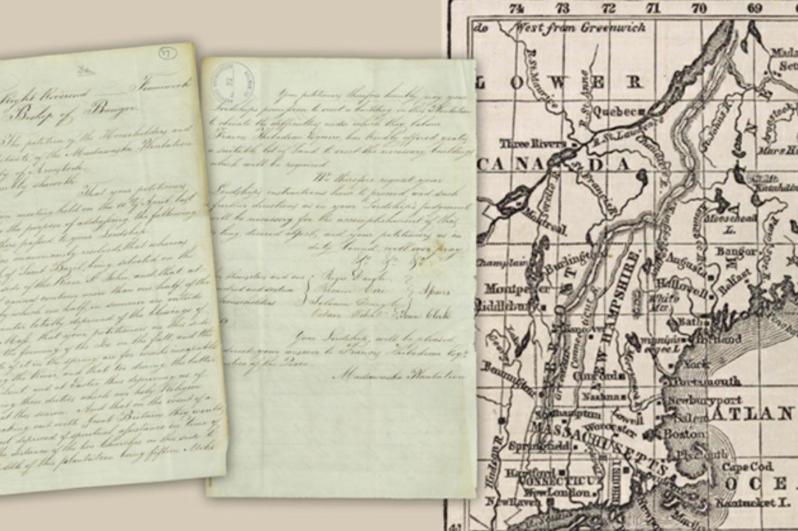Catholics of northern Maine petition for a church
In the papers of Bishop Benedict Fenwick is a petition from Catholics of the Madawaska Plantation, along the St. John River, which forms the border with Canada. The petition was the result of an April 10, 1846, meeting of local Catholics in which it was unanimously resolved to petition Bishop Fenwick for permission to build a church in their immediate vicinity.
This region of Maine was settled by Acadians, descendants of the French who settled in Canada, starting around 1785. Many formerly lived in New Brunswick but moved south into what is now the State of Maine to avoid British rule. The region was not clearly defined until the Webster-Ashburton Treaty of August 1842, which, among other items, settled the borders of the northeastern states and Canada.
The petition explains that the nearest church, the Church of St. Basile, resided on the opposite side of the St. John River in British territory. Crossing the river, and covering such a great distance, posed a problem for Catholics on the Maine side of the river. In the summer, farming occupied the time of the parishioners; in the fall, the harvesting of ice; and, in the spring, the river swelled and was impassable for weeks, so the people were often "totally deprived of the blessings of hearing Mass." Though the 1842 treaty eased tensions along the border, the petition makes the point that, in the event of war with Great Britain, Catholics in the region would be deprived of worship at a time of great need.
The document continues that a Mr. Francis Thibodeau, Esq. has offered to provide a piece of land on the plantation for the purpose of building a church. It concludes by asking Bishop Fenwick to send instructions on how to proceed with establishing a parish and church, "this so long desired object." Regis Daigle, Firmin Cire, Silvain Daigle, and Octave Hebert (town clerk) signed "for themselves and one hundred and sixteen householders."
A second document in the bishop's papers dating to July 23, 1846, reveals he replied on June 17, prompting a meeting of Madawaska Plantation Catholics on July 7, which is recounted in the text. At the meeting, "three free holders were unanimously chosen; one from each end of the parish and one from the centre," to measure the distance to the center of the plantation with the intention of building the church at that location. The exact center was found to be unfit for such a purpose in every way, so the committee was authorized to find a more suitable spot, which was discovered 15 acres below the center and had upon it the necessary raw materials for building a church.
No longer enclosed, the letter included the deed to the property and an additional request for the bishop to come to consecrate the church once completed, but it was not to be. On Aug. 8, Bishop Fenwick fell severely ill and died three days later.
One year later, in August 1847, Bishop Fenwick's successor, Bishop John Fitzpatrick, would travel throughout Maine, including to this northernmost region. He describes it as "a settlement of Acadians from Nova Scotia and Canadians extending from the Grand Fall to Fish River on either side of the St. John [River]." He continues that "the land is excellent in most parts and the farms in a thriving condition. The population is exclusively Catholic."
He references the Webster-Ashburton Treaty and that, although this area now falls within the Diocese of Boston, it fell within the Diocese of New Brunswick when Bishop William Dollard was appointed its ordinary, and therefore, there is some ambiguity as to who should provide for Catholics in that area. Bishop Fitzpatrick notes that Bishop Dollard is writing to Rome for clarification but, in the meantime, agreed the bishop of Boston would provisionally care for Catholics residing in northern Maine.
Bishop Fitzpatrick's visit to Maine is detailed in the bishops' journals, where it was standard for the bishop to write in the third person, referring to himself as "the bishop." At one point during his trip, he records:
"During this time the B'p is called upon by the Parishioners residing on the American side. They wish to be detached from the parish of St. Basile on account of the difficulty of crossing the river which is at certain seasons of the year dangerous from the ice and floods. They have already commenced building a church of considerable dimension and had the authorization of B'p Fenwick. As the parish is very large and the people on the British (sic.) side sufficiently numerous to form a congregation of themselves, the B'p encourages the American to continue and promises a priest when it is possible."
For several years after these events, a U.S. Catholic directory entry for Madawaska simply states, "in this section, allotted to the State of Maine by the late treaty with Great Britain, there are two Catholic churches, served by clergymen from Quebec. The inhabitants are mostly Canadian French."
It should also be noted that the borders of the "Madawaska Plantation" seem to have extended beyond the modern town of Madawaska, Aroostook County, Maine.
- Father Thomas Ryan, CSP, directs the Paulist North American Office for Ecumenical and Interfaith Relations in Boston.



















